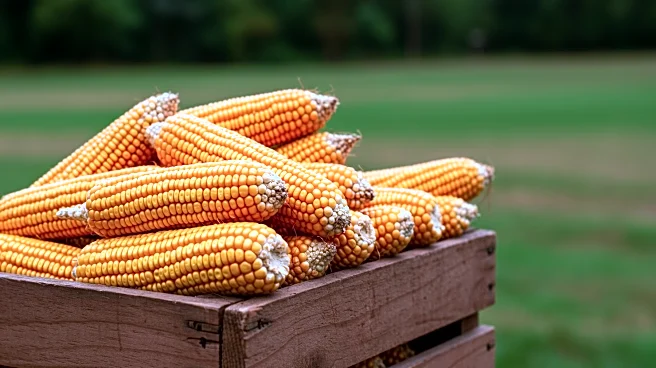What's Happening?
The National Corn Growers Association (NCGA) is urging Congress and the administration to take immediate action following the U.S. Department of Agriculture's report projecting a record 16.7-billion-bushel corn crop for 2025. This projection threatens farmers' livelihoods due to already low corn prices. NCGA President Kenneth Hartman Jr. emphasized the need for market-based solutions to increase corn demand, including the passage of E15 legislation for year-round consumer access to higher ethanol blends and the opening of new foreign markets. The projected average yield is 188.8 bushels per acre, marking a significant increase from previous records.
Why It's Important?
The record corn crop poses a significant challenge for U.S. farmers, who are already struggling with low prices. Without increased demand, the surplus could further depress prices, impacting farmers' financial stability. The proposed E15 legislation could boost demand by allowing higher ethanol blends, potentially utilizing an additional 457 million bushels of corn. Expanding foreign markets is crucial for sustaining the industry, with countries like India, Vietnam, and Kenya identified as strategic partners. The situation echoes past agricultural crises, highlighting the need for proactive measures to prevent long-term economic impacts on the farming community.
What's Next?
The NCGA is intensifying its advocacy for legislative action and international trade deals to address the surplus. The passage of E15 legislation is a key focus, as it offers a cost-effective solution to increase domestic demand. Additionally, the administration is urged to finalize and broker new trade agreements to open foreign markets. The outcome of these efforts will be critical in determining the economic future of U.S. corn growers, with potential implications for related industries and rural economies.
Beyond the Headlines
The current situation underscores broader issues in agricultural policy and market dynamics. The reliance on legislative and trade solutions highlights vulnerabilities in the agricultural sector, where external factors can significantly impact economic stability. The push for ethanol blends also reflects ongoing debates about energy policy and environmental impacts, as higher ethanol use could influence fuel markets and emissions standards.















